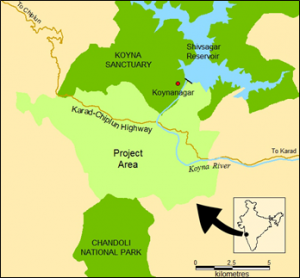Domestic sewage processing plant of 1.0 MLD capacity
| Capacity(KLD) | 1000 |
| Category | Sewage |
| Location | Gora, Gujurat |
| Sl no. | 1 |
| Status | WIP |
| Year | 2020-21 |


The verdant forests of Koyna Valley form a part of the Western Ghats (or colloquially in India, the Sahyadhris) – a mountain range that runs parallel to the Western coast of the Indian Peninsula. The Western Ghats are recognized as one of the International Hotspots Biodiversity, and is home to several rare and endangered species of plants and animals, some of which, like the Malabar Giant Squirrel, are endemic to this area.
Not all swatches of forests in this area are under the control of the Forest Depatment. In fact, many private land holdings in this area also have a forest cover. In the local lingo, the word “Malki” means Private Land. So, Malki Forests – forests on private land – are found extensively in the Western Ghats.
Malki forests, therefore, are of tremendous importance, and play a significant ecological role of providing green cover, conserving soil and biodiversity, landscape connectivity for wildlife and regulate water flow of the many rivers that originate in the Western Ghats. From an anthropocentric perspective, the Malkiforests provide valuable forest produce to their owners and to the community.
Unfortunately, as is true elsewhere in the world today, these forests are often found to be in a degraded state because of over extraction of forest produce and concurrent poor management. Among the many causes, tree cutting for sale as firewood stands out as one of the main causes of degradation. However, given the huge body of knowledge and experience available the world over, it is possible to systematically and scientifically manage these forests, so that they are given the time and space to recover. Thus, Malkiforests can not only provide monetary returns to the owners, but can also complement the existing neighbouring forests in providing valuable ecosystem services.
To put it very simply, conserving existing forest resources is by far a cheaper and more effective way than creating new forests on barren land. With this possibility in view, the Wildlife Research and Conservation Society (WRCS), a non-governmental organisation (NGO), based in the metropolitan city of Pune in the state of Maharashtra, in India, have initiated a “Protect Koyna Private Forests” Project in the Koyna area, not far from there.

The agenda of “Protect Koyna Private Forests” Project is very simple… conservation of malki forests in Koyna region of Western Ghats. There is a special reason for the choice of this particular area. This region (see map) is in buffer forest zone of Sahyadri Tiger Reserve and is a connecting link between KoynaSanctuary and Chandoli National Park. The area proposed to be covered by this project is 80 sq.km. Apart from the various ecological advantages of this project, protection of this area will create a natural corridor between the two now-disjointed stretches of prime forest. The broader advantages that these forests will provide as carbon sinks in the Global Warming game goes without saying.

Among the various methodologies listed above, the one intervention that could prove to be a game changer is provision of incentives for conservation. The logic is simple and straight-forward. The local stakeholders are often unwilling to change their existing practices because of the immediate short term benefits that they receive and perceive, even though these practices may be harmful to them also in the long term. Conservation incentives is a widely implemented strategy of offering monetary or in-kind incentives to the stakeholders for encouraging them to adopt sustainable management practices. The incentives are generally low, but sufficient to motivate the stakeholders to adopt the sustainable management practices. An amount as low as Rs. 2,000/- (About $32 or €30 at today’s rates) can protect 2 acres (or about 0.8 hectare).

Do you care about sustainability and water management. Join the list to receive our research and thoughts and be part of the active community.
| Capacity(KLD) | 1000 |
| Category | Sewage |
| Location | Gora, Gujurat |
| Sl no. | 1 |
| Status | WIP |
| Year | 2020-21 |